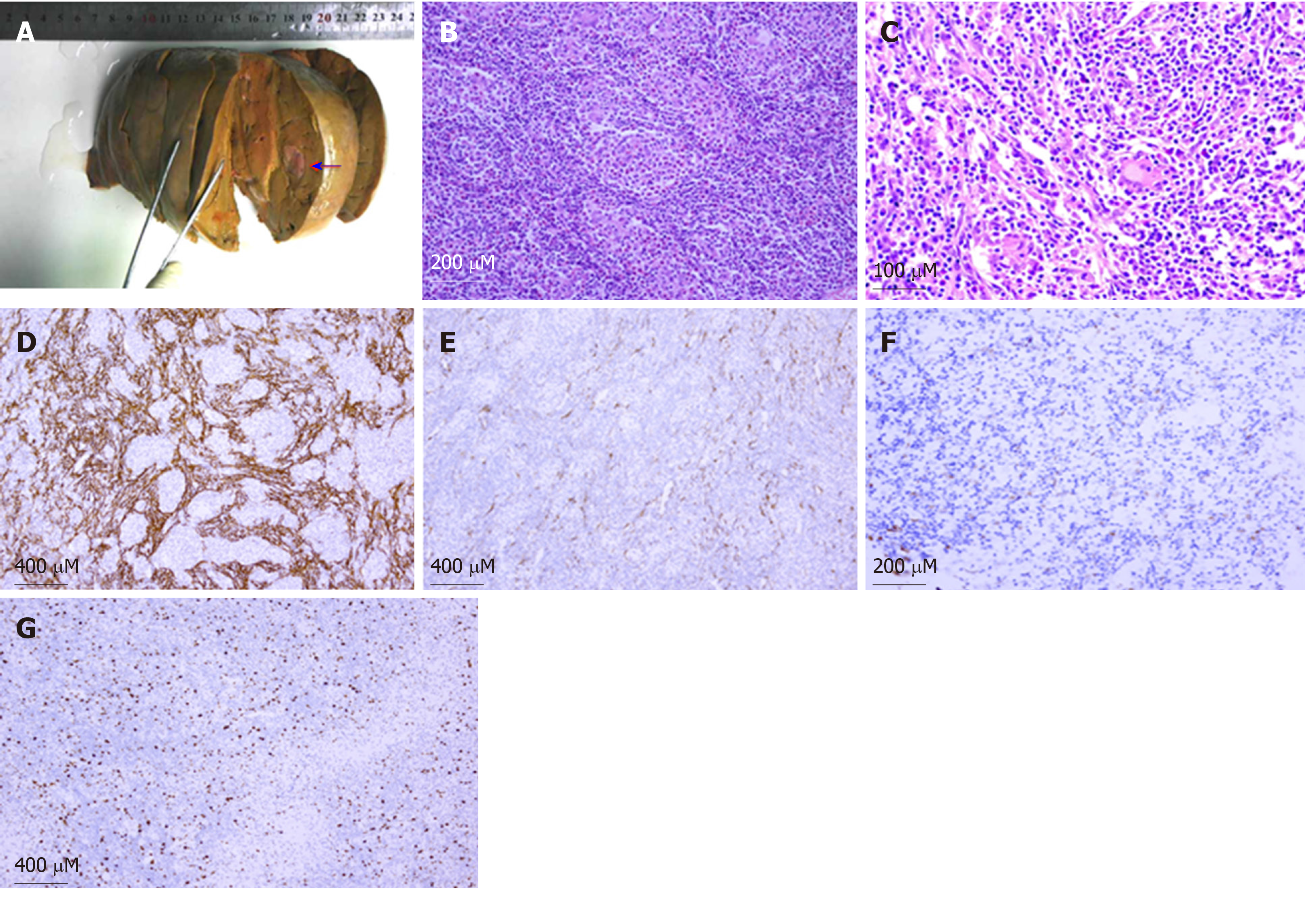Copyright
©The Author(s) 2019.
World J Gastrointest Oncol. Dec 15, 2019; 11(12): 1231-1239
Published online Dec 15, 2019. doi: 10.4251/wjgo.v11.i12.1231
Published online Dec 15, 2019. doi: 10.4251/wjgo.v11.i12.1231
Figure 1 Magnetic resonance imaging.
Two well-circumscribed lesions with long T1 and long or equal T2 signal (arrows). The multiple lesions with long T1 and long T2 signal are hepatic cysts verified by pathological examination later.
Figure 2 Abdominal computed tomography examination.
The images show an ill-defined and low-density 10 cm mass (arrows) in the right lobe of the liver, accompanied with enlargement of hepatic portal lymph nodes.
Figure 3 Epstein-Barr virus-positive inflammatory pseudotumor-like follicular dendritic cell sarcoma in the liver.
A: Gross picture of an inflammatory pseudotumor-like follicular dendritic cell sarcoma of the liver. A well-circumscribed solid nodule was found in the liver. Note the grayish-white colored and soft cut surface with focal hemorrhage (arrow); B: Haematoxylin and eosin stained image showing that the tumor tissue had a meshwork-like architecture (× 200); C: On high-power field, the tumor was composed of oval to spindle cells with vesicular chromatin and distinct nucleoli. There was less degree of atypia. The background showed abundant lymphocytes and plasma cells (× 400); D: CD21 was detected on the membrane of almost all of tumor cells by immunohistochemistry (× 100); E: Smooth muscle actin was detected in the cytoplasm of a part of tumor cells by immunohistochemistry (× 100); F: Epstein-Barr virus-encoded small RNA-based in situ hybridization demonstrated positive nuclei of the neoplastic dendritic cells (× 200); G: Ki-67 was detected in the nuclei of almost all of tumor cells by immunohistochemistry (30%; × 100).
Figure 4 Epstein-Barr virus positive inflammatory pseudotumor-like follicular dendritic cell sarcoma in the liver with hepatoduodenal ligament lymph node involvement.
A: Gross picture of an inflammatory pseudotumor-like follicular dendritic cell sarcoma of the liver. A large and multinodular confluent tumor was found in the liver (arrow); B: Histologic sections of follicular dendritic cell sarcoma showing an unencapsulated tumor (left) with a sharp margin from the adjacent liver parenchyma (right). The tumor tissue was arranged in whorls (× 40); C: On high-power field, the tumor was composed of oval to spindle cells with vesicular chromatin and distinct nucleoli. There was less degree of atypia. The background showed abundant lymphocytes and plasma cells (× 400); D: In the hepatoduodenal ligament lymph node, lymphoid follicles were pushed aside by tumor tissue (× 100); E: CD21 was detected on the membrane of almost all of tumor cells by immunohistochemistry (× 100); F: S100 was detected in the membrance and cytoplasm of almost all of tumor cells by immunohistochemistry (× 100); G: Epstein-Barr virus-encoded small RNA in situ hybridization demonstrated positive nuclei of the neoplastic dendritic cells (× 100); H: Ki-67 was detected in the nuclei of almost all of tumor cells (20%; × 100).
- Citation: Zhang BX, Chen ZH, Liu Y, Zeng YJ, Li YC. Inflammatory pseudotumor-like follicular dendritic cell sarcoma: A brief report of two cases. World J Gastrointest Oncol 2019; 11(12): 1231-1239
- URL: https://www.wjgnet.com/1948-5204/full/v11/i12/1231.htm
- DOI: https://dx.doi.org/10.4251/wjgo.v11.i12.1231












